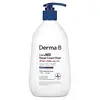What's inside
What's inside
 Key Ingredients
Key Ingredients

 Benefits
Benefits

 Concerns
Concerns

 Ingredients Side-by-side
Ingredients Side-by-side

Water
Skin ConditioningSodium Cocoamphoacetate
CleansingLauryl Glucoside
CleansingGlycerin
HumectantSodium Cocoyl Glutamate
CleansingSodium Lauryl Glucose Carboxylate
CleansingCeramide NP
Skin ConditioningPiroctone Olamine
PreservativeCapryloyl Glycine
CleansingCaprylyl Glycol
EmollientCitric Acid
BufferingPEG-120 Methyl Glucose Trioleate
CleansingPolyquaternium-67
Propylene Glycol
HumectantSilicone Quaternium-8
Undecylenoyl Glycine
CleansingWater, Sodium Cocoamphoacetate, Lauryl Glucoside, Glycerin, Sodium Cocoyl Glutamate, Sodium Lauryl Glucose Carboxylate, Ceramide NP, Piroctone Olamine, Capryloyl Glycine, Caprylyl Glycol, Citric Acid, PEG-120 Methyl Glucose Trioleate, Polyquaternium-67, Propylene Glycol, Silicone Quaternium-8, Undecylenoyl Glycine
Water
Skin ConditioningSodium Cocoyl Isethionate
CleansingGlycerin
HumectantDisodium Cocoamphodiacetate
CleansingSodium Chloride
MaskingHydroxypropyl Starch Phosphate
Potassium Cocoyl Glycinate
Citric Acid
BufferingCetearyl Olivate
Dipropylene Glycol
Humectant1,2-Hexanediol
Skin ConditioningSorbitan Olivate
EmulsifyingHydroxyacetophenone
AntioxidantPanthenol
Skin ConditioningPolyquaternium-67
Polyquaternium-10
Hexylene Glycol
EmulsifyingDisodium EDTA
Butyrospermum Parkii Butter
Skin ConditioningCaprylamide Mea
AntioxidantVitis Vinifera Seed Oil
EmollientMyristoyl/Palmitoyl Oxostearamide/Arachamide Mea
Skin ConditioningButylene Glycol
HumectantHydrogenated Lecithin
EmulsifyingOlea Europaea Fruit Oil
MaskingGlycolipids
Skin ConditioningCeramide NP
Skin ConditioningCandida Bombicola/Glucose/Methyl Rapeseedate Ferment
AntimicrobialWater, Sodium Cocoyl Isethionate, Glycerin, Disodium Cocoamphodiacetate, Sodium Chloride, Hydroxypropyl Starch Phosphate, Potassium Cocoyl Glycinate, Citric Acid, Cetearyl Olivate, Dipropylene Glycol, 1,2-Hexanediol, Sorbitan Olivate, Hydroxyacetophenone, Panthenol, Polyquaternium-67, Polyquaternium-10, Hexylene Glycol, Disodium EDTA, Butyrospermum Parkii Butter, Caprylamide Mea, Vitis Vinifera Seed Oil, Myristoyl/Palmitoyl Oxostearamide/Arachamide Mea, Butylene Glycol, Hydrogenated Lecithin, Olea Europaea Fruit Oil, Glycolipids, Ceramide NP, Candida Bombicola/Glucose/Methyl Rapeseedate Ferment
Ingredients Explained
These ingredients are found in both products.
Ingredients higher up in an ingredient list are typically present in a larger amount.
Ceramide NP is a type of ceramide and formally known as ceramide 3.
Ceramides are intercellular lipids naturally found in our skin that bonds dead skin cells together to create a barrier. They are known for their ability to hold water and thus are a great ingredient for dry skin.
Ceramides are an important building block for our skin barrier. A stronger barrier helps the skin look more firm and hydrated. By bolstering the skin ceramides act as a barrier against irritating ingredients. This can help with inflammation as well.
If you would like to eat ceramides, sweet potatoes contain a small amount.
Read more about other common types of ceramides here:
Ceramide AP
Ceramide EOP
Citric Acid is an alpha hydroxy acid (AHA) naturally found in citrus fruits like oranges, lemons, and limes.
Like other AHAs, citric acid can exfoliate skin by breaking down the bonds that hold dead skin cells together. This helps reveal smoother and brighter skin underneath.
However, this exfoliating effect only happens at high concentrations (20%) which can be hard to find in cosmetic products.
Due to this, citric acid is usually included in small amounts as a pH adjuster. This helps keep products slightly more acidic and compatible with skin's natural pH.
In skincare formulas, citric acid can:
While it can provide some skin benefits, research shows lactic acid and glycolic acid are generally more effective and less irritating exfoliants.
Most citric acid used in skincare today is made by fermenting sugars (usually from molasses). This synthetic version is identical to the natural citrus form but easier to stabilize and use in formulations.
Read more about some other popular AHA's here:
Learn more about Citric AcidGlycerin is already naturally found in your skin. It helps moisturize and protect your skin.
A study from 2016 found glycerin to be more effective as a humectant than AHAs and hyaluronic acid.
As a humectant, it helps the skin stay hydrated by pulling moisture to your skin. The low molecular weight of glycerin allows it to pull moisture into the deeper layers of your skin.
Hydrated skin improves your skin barrier; Your skin barrier helps protect against irritants and bacteria.
Glycerin has also been found to have antimicrobial and antiviral properties. Due to these properties, glycerin is often used in wound and burn treatments.
In cosmetics, glycerin is usually derived from plants such as soybean or palm. However, it can also be sourced from animals, such as tallow or animal fat.
This ingredient is organic, colorless, odorless, and non-toxic.
Glycerin is the name for this ingredient in American English. British English uses Glycerol/Glycerine.
Learn more about GlycerinWe don't have a description for Polyquaternium-67 yet.
Water. It's the most common cosmetic ingredient of all. You'll usually see it at the top of ingredient lists, meaning that it makes up the largest part of the product.
So why is it so popular? Water most often acts as a solvent - this means that it helps dissolve other ingredients into the formulation.
You'll also recognize water as that liquid we all need to stay alive. If you see this, drink a glass of water. Stay hydrated!
Learn more about Water